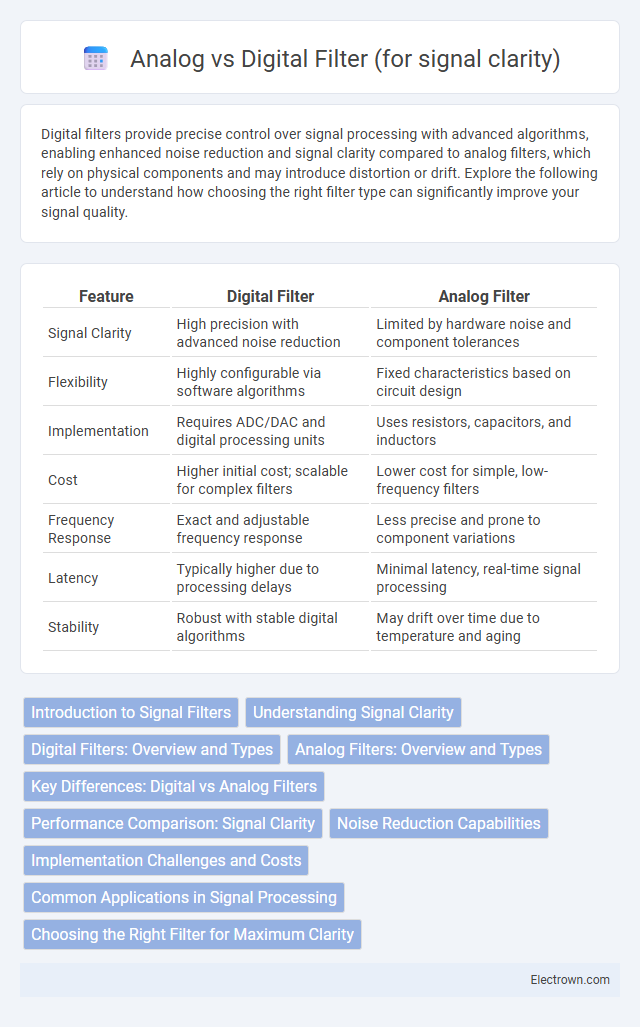Digital filters provide precise control over signal processing with advanced algorithms, enabling enhanced noise reduction and signal clarity compared to analog filters, which rely on physical components and may introduce distortion or drift. Explore the following article to understand how choosing the right filter type can significantly improve your signal quality.
Table of Comparison
| Feature | Digital Filter | Analog Filter |
|---|---|---|
| Signal Clarity | High precision with advanced noise reduction | Limited by hardware noise and component tolerances |
| Flexibility | Highly configurable via software algorithms | Fixed characteristics based on circuit design |
| Implementation | Requires ADC/DAC and digital processing units | Uses resistors, capacitors, and inductors |
| Cost | Higher initial cost; scalable for complex filters | Lower cost for simple, low-frequency filters |
| Frequency Response | Exact and adjustable frequency response | Less precise and prone to component variations |
| Latency | Typically higher due to processing delays | Minimal latency, real-time signal processing |
| Stability | Robust with stable digital algorithms | May drift over time due to temperature and aging |
Introduction to Signal Filters
Signal filters enhance signal clarity by selectively allowing desired frequencies while attenuating unwanted noise. Analog filters use continuous-time circuits with components like resistors and capacitors to process signals in real-time, offering simplicity and low latency. Digital filters operate on discrete-time data with algorithms that provide flexibility, precision, and adaptability in complex signal environments.
Understanding Signal Clarity
Digital filters enhance signal clarity by precisely removing noise and unwanted frequencies through algorithms, providing consistent and adaptable performance. Analog filters rely on physical components like resistors and capacitors, which can introduce slight distortions and less flexibility in adjusting filter parameters. Your choice of filter impacts the accuracy and quality of signal processing in applications such as audio, telecommunications, and instrumentation.
Digital Filters: Overview and Types
Digital filters process signals using mathematical algorithms to enhance clarity by selectively removing noise and unwanted frequencies. Key types include Finite Impulse Response (FIR) filters, known for their linear phase response, and Infinite Impulse Response (IIR) filters, which offer efficient implementation with recursive feedback. Advanced digital filtering techniques enable precise control over frequency response, stability, and computational complexity, making them ideal for modern signal processing applications.
Analog Filters: Overview and Types
Analog filters process continuous-time signals using passive or active components such as resistors, capacitors, and inductors to achieve desired frequency responses. Common types of analog filters include low-pass, high-pass, band-pass, and band-stop, each designed to selectively allow or attenuate specific frequency ranges for enhanced signal clarity. These filters are essential in applications requiring real-time processing and minimal latency, such as audio engineering and radio communications.
Key Differences: Digital vs Analog Filters
Digital filters process signals using discrete computations, allowing precise control over filter characteristics and enabling complex operations like adaptive filtering and noise reduction. Analog filters rely on continuous-time electronic components such as resistors, capacitors, and inductors to shape signal frequency response, offering low latency and simplicity in real-time applications. The key differences between digital and analog filters include flexibility, precision, implementation complexity, and susceptibility to noise, with digital filters excelling in accuracy and programmability, while analog filters provide faster response and simplicity in hardware design.
Performance Comparison: Signal Clarity
Digital filters provide superior signal clarity by effectively reducing noise and distortion through precise mathematical algorithms, ensuring consistent performance across varying conditions. Analog filters, while offering real-time processing with low latency, often suffer from component tolerances and signal degradation, which can compromise clarity. Your choice depends on the need for accuracy and consistent clarity versus simplicity and real-time response in signal processing.
Noise Reduction Capabilities
Digital filters provide superior noise reduction capabilities compared to analog filters due to their ability to implement complex algorithms that precisely target unwanted frequencies, enhancing signal clarity without distortion. Analog filters rely on physical components, which are subject to tolerances and variations, limiting the effectiveness of noise suppression. Your choice of a digital filter ensures more accurate and adaptable noise elimination, crucial for high-fidelity signal processing applications.
Implementation Challenges and Costs
Digital filters require complex algorithms and advanced hardware, leading to higher initial development costs but offering greater flexibility and precision in signal clarity enhancement. Analog filters rely on physical components like resistors and capacitors, making them simpler and cheaper to implement but prone to component tolerance issues and limited adaptability. Your choice depends on balancing upfront investment against long-term performance and maintenance considerations.
Common Applications in Signal Processing
Digital filters excel in applications such as audio signal enhancement, telecommunications, and biomedical signal processing due to their ability to precisely manipulate signals with complex algorithms and adaptive filtering. Analog filters remain prevalent in real-time systems like radio frequency reception, sensor signal conditioning, and basic noise reduction where minimal latency and simpler circuitry are crucial. Signal clarity in digital filters surpasses analog when dealing with complex, multi-frequency signals, while analog filters maintain advantages in low-power, high-frequency environments.
Choosing the Right Filter for Maximum Clarity
Selecting the right filter for maximum signal clarity depends on the application-specific noise characteristics and processing requirements. Digital filters offer precise control, adaptability, and stability, making them ideal for complex, variable signals and environments requiring fine-tuned filtering. Analog filters provide low-latency responses and simplicity for real-time, high-frequency applications but lack the flexibility and precision of digital counterparts in handling diverse noise profiles.
Digital vs Analog Filter (for signal clarity) Infographic

 electrown.com
electrown.com